Home » Tire Patches vs. Tire Plugs: Which Is Better?
What are tire patches and tire plugs? Well, they are useful when you get a flat tire. In such cases, there’s a good chance that a minor repair can get you back up and running again quickly.
Three of the most common of these “minor repairs” are:
The first option, a tire plug, is cheap and fast to administer. Plugs work best when you’ve run over a nail or similar blunt object that punctures the tire and causes it to leak air. After the nail or sharp object is removed, the plug can be inserted into the hole to fix the leak. While plugs of the old days were problematic and served more as a band-aid type of repair than anything else, many plugs available today actually vulcanize to the tire to provide better stability.
Tire patchA patch, on the other hand, is considered to be a better quality tire repair. However, it’s a bit more laborious of a repair than a plug. Patching a tire actually consists of removing the tire from the rim and then using a die grinder to clean up a 2-inch diameter around the puncture to give the patch enough of an area to bond with. The patch is then pushed from inside the tire through the outside of the tire, sealed, and let dry.
The best modern tire repair solution is a plug/patch combo product. This is one piece and it combines the best benefits of both options.
Keep in mind that not all tire damage can be repaired. For example, tire bubbles are a dangerous problem that will result in needing new tires.
The question is: Can or should you repair a tire on your own?
If you purchased your tires from a mechanic or tire-specific business, then chances are they will either plug or patch your tire for free if it develops a leak and a patch or plug can resolve the issue.
Tire plugMany tire-specific businesses will also fix your tire via these means as a way of developing goodwill with you, the customer, so that when it comes to buying new tires you’ll consider purchasing that next set from them.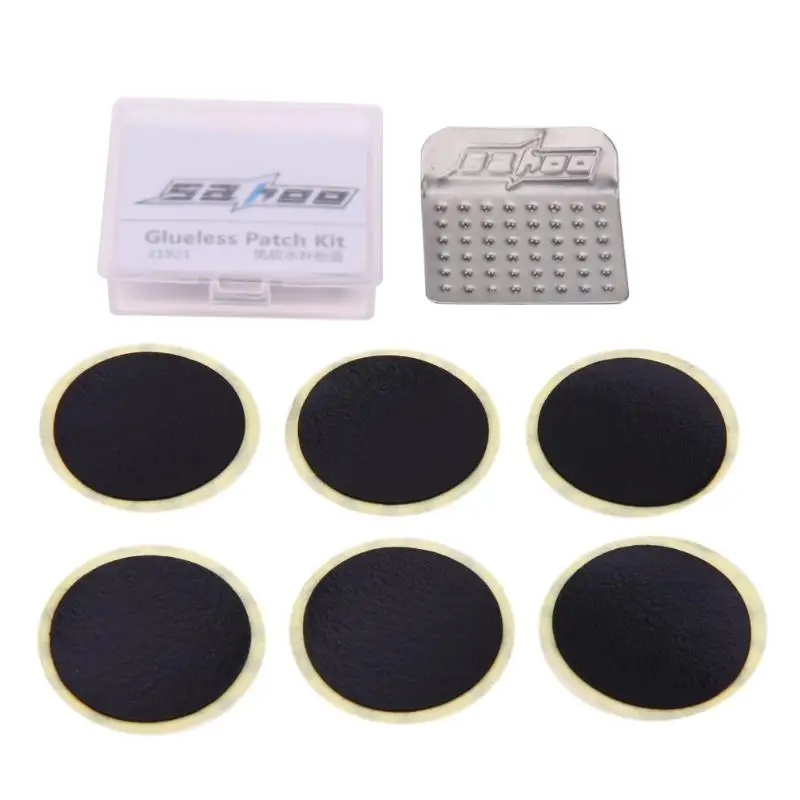
However, outside of these two scenarios, tire patching and plugging aren’t necessarily expensive (usually only $10-$20 a repair), but more of an inconvenience.
Considering this, patching your tires on your own might not be worth it.
DIY patching or plugging is still an option, yet we’d advise you to be absolutely sure of what you’re doing before going the patching route.
The plugging route is fairly simple (and cheap, as plug kits can be purchased for just a few dollars), as all you really need to do is locate the hole and insert the plug. Going the patching route is also fairly inexpensive, but there’s a lot more involved.
For instance, patching a tire consists of:
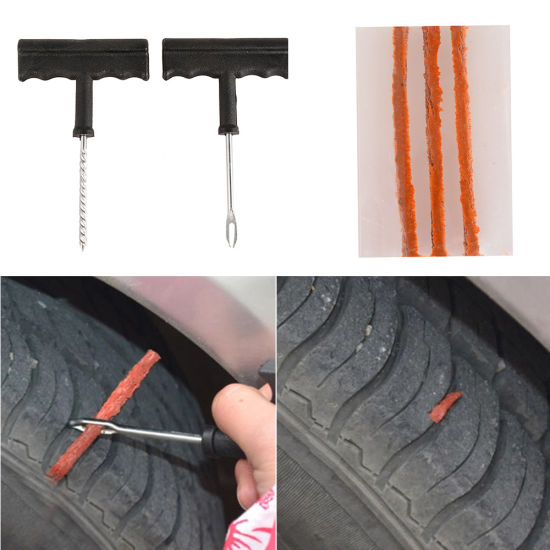
Plugs won’t usually work when a puncture is near the sidewall, as it likely won’t be able to completely seal the area. Plugs are also ineffective when the puncture is on an angle. Patches are usually the better-recommended option, but they do have their limitations. For instance, if a puncture is greater than a quarter-inch in diameter, a patch will likely be ineffective and the tire may be too damaged to repair.
What’s better – tire plugs or tire patches?Plugs, when installed correctly and in the right situations, can help a tire last for up to 25,000 additional miles. But while plugs can be effective, usually patches are considered to be the better, more secure option of the two. The patch/plug combo is the safest and most reliable option.
But while plugs can be effective, usually patches are considered to be the better, more secure option of the two. The patch/plug combo is the safest and most reliable option.
Yes and no. Years ago they were and if they aren’t installed correctly or in the right situations today, they still are. However, today’s plugs vulcanize to the tire and can help it last for tens of thousands of miles more.
If you’ve ever had a flat tire, you know the feeling of panic that sets in. Whether on the side of the road or in your driveway, all you can think about is getting your tire fixed as quickly as possible. But what’s the best way to fix a flat tire? Should you plug or patch it?
While both methods will get your tire back to functioning properly, there are some critical differences between the two. Tire plugs are typically used for smaller punctures, while patches are better for bigger holes. Plugging a tire is also generally a quicker and easier process than patching.
Plugging a tire is also generally a quicker and easier process than patching.
So, what’s the verdict? If you’re unsure which method to use, here’s a quick guide to help you make the best decision for your flat tire.
IntroductionAt some point, every driver will experience a flat tire. Whether you hit a pothole or run over a nail, it’s essential to know how to properly repair your tire so you can get back on the road safely. But what’s the best way to fix a flat? Should you plug or patch your tire?
There are two main ways to repair a flat tire: plugs and patches. Both methods have their advantages and disadvantages, so it’s important to know what each option entails before deciding. Here’s a brief overview of each repair method:
Tire plugs are inserted into the hole in your tire to seal it and prevent air from escaping. Plugs are typically made of rubber or foam and are relatively easy to install yourself with the help of a plug kit.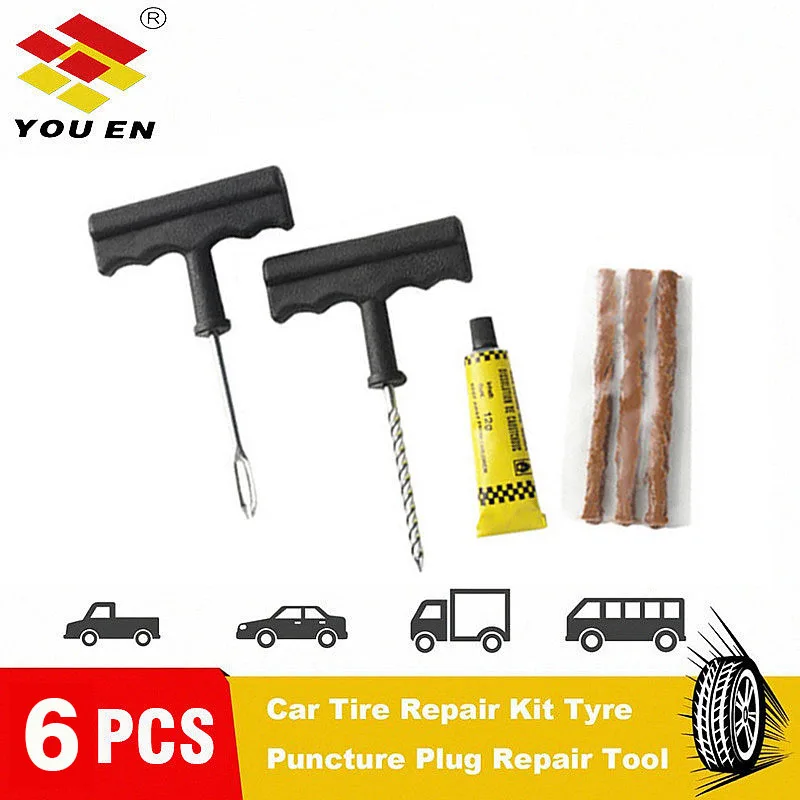
One advantage of using tire plugs is that they’re less expensive than patches. They’re also quick and easy to install, which is ideal if you’re stranded on the side of the road with a flat tire. However, one downside of plugs is that they’re not as durable as patches and may not last as long. Additionally, some experts believe that plugs can actually cause more damage to your tires over time.
Tire patches are applied to the outside of your tire and bonded with adhesive. Unlike plugs inserted into your tires, patches are used to cover holes in the outermost layer of your tire (the tread). Patches are generally considered more durable than plugs and they provide a longer-lasting repair. However, they can be more difficult to install yourself and they typically cost more than plugs.
If you have a choice between patching or plugging your tire, most experts recommend patching because it provides a stronger, longer-lasting repair. However, both methods can be effective ways to fix a flat tire if done properly.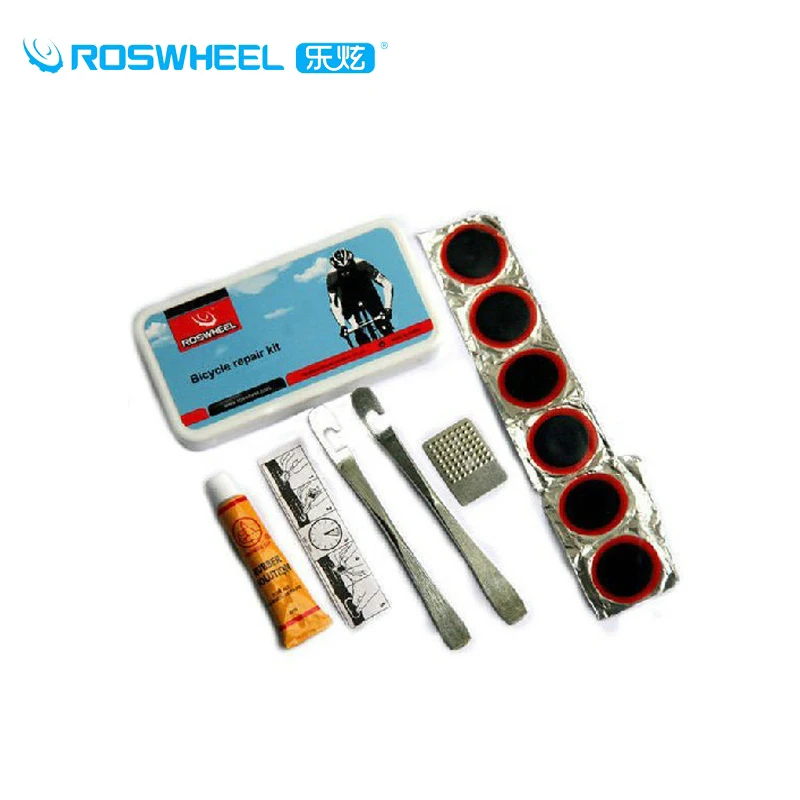 If you’re unsure about which option is best for your situation, it’s always best to consult with a professional before making a decision.
If you’re unsure about which option is best for your situation, it’s always best to consult with a professional before making a decision.
A tire plug is a temporary fix for a punctured tire. It is a piece of rubber or other material that is inserted into the hole in the tire to seal it and prevent air from escaping.
What is a tire patch?A tire patch is a small piece of rubber that is used to repair a hole or puncture in a tire. There are two types of tire patches: inner tube patches and tubeless patches. Inner tube patches are used on tires that have an inner tube, while tubeless patches are used on tires that do not have an inner tube.
How to plug a tireIf you have a flat tire, you may be wondering whether you should plug or patch it. Tire plugs and patches each have their own advantages and disadvantages, so it’s important to know what to consider before making a decision.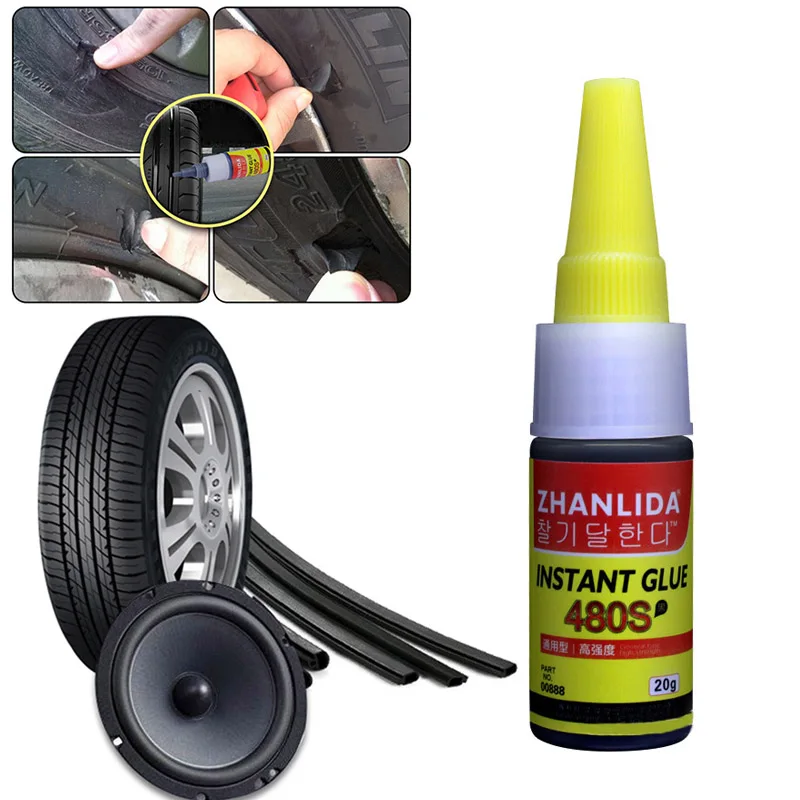
Let’s take a closer look at the benefits and drawbacks of each option so you can make the best decision for your situation.
Tire plugs are inserted into the hole in your tire to seal it and prevent air from escaping. Plugs are typically made of rubber or latex, and they’re relatively easy to install yourself.
One advantage of tire plugs is that they’re typically less expensive than patches. They’re also quick and easy to install, which can be important if you’re stranded on the side of the road with a flat tire.
However, there are some drawbacks to tire plugs as well. One is that they don’t always provide a permanent fix; the plug could come out over time, which would leave you with another flat tire. Additionally, air can still leak around the edges of the plug, so it may not hold pressure as well as a patch. And finally, some tire experts believe that plugs can actually weaken the sidewall of your tire, making it more susceptible to future flats.
Patching Your Tire Patching your tire involves bonding a patch over the hole in your tire to create a new airtight surface. Patches are usually made from vulcanized rubber, which means they can provide a very strong and permanent repair.
One advantage of patches is that they’re very sturdy and long-lasting; once a patch is installed, it shouldn’t come off or allow air to escape. Additionally, because patch bonding material actually permeates into tiny crevices in the sidewall of your tire, it can provide an even stronger repair than a plug.
There are some disadvantages to patching as well, though. One is that it’s typically more expensive than installing a plug; you’ll need to pay for both the patch itself and for labour if you have someone else do it for you. Additionally, because patches require removal of the tire from the rim (to allow access for bonding material), they usually take longer to install than plugs do
How to patch a tireThere are two ways to fix a flat tire: You can either plug it or patch it. Both methods are fairly easy to do, but they each have their own set of pros and cons.
Both methods are fairly easy to do, but they each have their own set of pros and cons.
Tire plugs are typically made of rubber or latex and are inserted into the tire to fill the hole. Tire plugs are a quick and easy fix, and they can be done without even taking the tire off of the car. However, tire plugs are not a permanent fix, and they may not be as effective in sealing larger holes.
Tire patches, on the other hand, require you to take the tire off of the car so that the hole can be patched from the inside. Tire patches are a more permanent solution, but they do require more time and effort to complete.
Tire plug vs tire patchThere are two different ways to fix a flat tire: with a tire plug or a tire patch. But which one is the better option?
Tire plugs are inserted into the hole in the tire to seal it up. They’re quick and easy to do, and they’re a temporary fix. Tire patches, on the other hand, are glued onto the hole in the tire.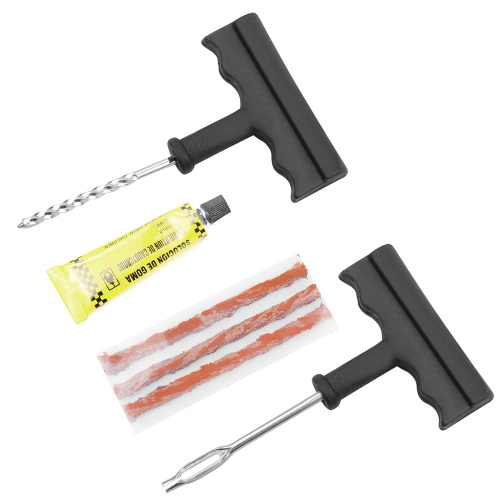 They take longer to do, but they’re a more permanent solution.
They take longer to do, but they’re a more permanent solution.
So, which one should you choose? If you have a small hole in your tire, a tire plug will probably be just fine. But if you have a large hole or if your tire is severely damaged, you’ll need a tire patch.
Tire servicesTire services can be performed at a wide variety of businesses, from car dealers to local gas stations. However, not every business offers the same quality or range of services. When it comes to something as important as your tires, it’s important to choose a reputable company that can offer the services you need.
There are two basic types of tire repair: plugs and patches. Both have their benefits and drawbacks, and the best choice for you will depend on the severity of the damage and your personal preferences.
Tire plugs are typically used for small punctures in the tread of the tire. They are inserted into the hole and then inflated, expanding to fill the hole and seal it off. Plugs are a quick and easy way to repair a flat tire, but they are not considered permanent fixes. They may also come out over time, especially if they are not installed correctly.
Plugs are a quick and easy way to repair a flat tire, but they are not considered permanent fixes. They may also come out over time, especially if they are not installed correctly.
Tire patches are similar to plugs, but they involve bonding a patch over the hole in the tire. This patch is then inflated along with the rest of the tire. Patches provide a more permanent solution than plugs, but they can be more difficult to install correctly.
Tire repair near meIt’s happened to all of us. You’re driving along and suddenly you hear that telltale thump, thump, thump. You pull over to the side of the road and discover you have a flat tire. Now what? For years, motorists have been debating whether it’s better to patch or plug a tire when they get a flat. The truth is, there is no definitive answer. It depends on the kind of tire damage you have and the condition of your tires. Here’s a look at the pros and cons of each method to help you decide what’s best for you.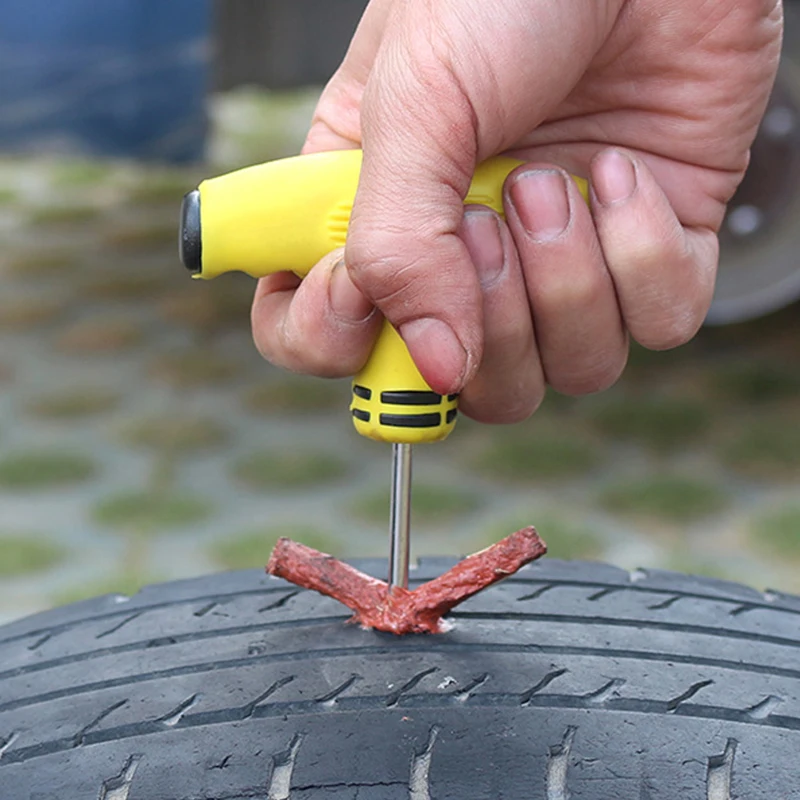
Patching a tire is generally considered to be the most reliable repair method because it offers a permanent fix. A professional technician will remove the wheel from your car, take out the damaged inner liner, clean the area around the hole, and apply a vulcanizing patch over the hole. The patch is then covered with cement before being inflated and checked for leaks.
Pros: Patching is a permanent repair that will strengthen the tire and prevent air from leaking.
Cons: Patching can be more expensive than other repair methods because it requires special equipment and training. In addition, some tire experts believe that patching may shorten the overall life of your tires because it can make them more susceptible to heat build-up. If not done correctly, patching can also cause further damage to your tires.
Plugging a tire is generally considered a temporary repair method that should only be used in emergencies. To plug a tire, a professional technician will insert a special rubber plug into the hole in your tire, and the plug is then inflated and checked for leaks.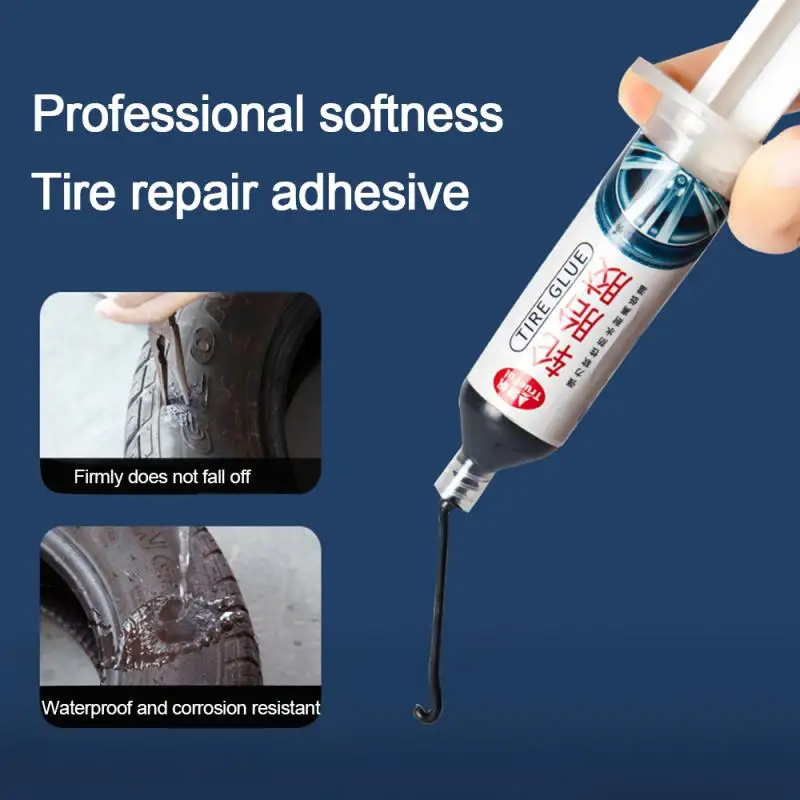
Pros: Plugging is less expensive than other repair methods and can usually be done quickly and easily by anyone with basic automotive knowledge.
Cons: Because it’s only a temporary fix, plugs can come out of your tires over time, causing air to leak out again. In addition, some experts believe that plugs can cause further damage to your tires because they leave holes in the tread that can collect water and snow, which can lead to sidewall or tread separations over time.
Back
In the last issue we wrote about the repair of minor tire defects. The author of the article - Pavel Ferdus, manufacturer of tire repair materials of the Czech company Ferdus - spoke in detail about the tire repair history of from the moment the first tire appeared to the present day, trends in this area and forecasts of how the tire repair business will develop in the future. In particular, he covered in detail the repair of such minor damage as tire punctures.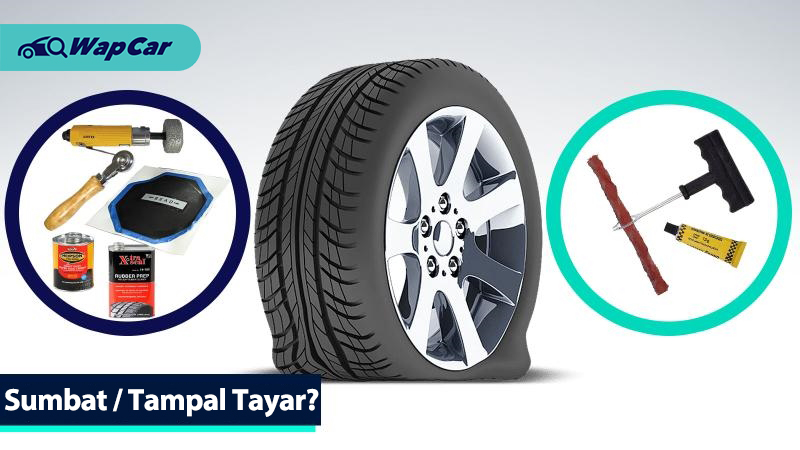 In this issue, we will continue the theme, only this time the focus will be more serious damage, namely tire breakdowns. At the same time, it will not be superfluous to look into the past again in order to predict the trends of the future.
In this issue, we will continue the theme, only this time the focus will be more serious damage, namely tire breakdowns. At the same time, it will not be superfluous to look into the past again in order to predict the trends of the future.
The first tires and the first punctures
Historically, tires have always – from their inception to the present day – been easily damaged. Even despite the fact that the first tires were quite thick, there were always a lot of various sharp objects on the roads, collisions with which would certainly end in serious tire damage - breakdowns.
Over time, both the car and tires have improved. Designers have always been interested in the optimal ratio of their strength and weight, but these requirements often contradict each other. On the one hand, an acceptable margin of safety and resistance to defects was necessary, and on the other hand, it was necessary that they copy the road surface with extreme accuracy.
The first tires were bias-ply and their surface was resilient. In bias-ply tires, the cords in the carcass plies run diagonally from bead to bead. Elasticity must also be maintained for the repair patch, as the main repair material for tire breakdowns. The repair patch for bias tires must be elastic and have the ability to change its size depending on the load.
In bias-ply tires, the cords in the carcass plies run diagonally from bead to bead. Elasticity must also be maintained for the repair patch, as the main repair material for tire breakdowns. The repair patch for bias tires must be elastic and have the ability to change its size depending on the load.
At one time, the bias tire was the most popular among car enthusiasts due to its elasticity and ability to "soften" surface irregularities. And yet, it is quite heavy, voluminous and expensive.
In the 60s of the last century, bias tires replaced radial tires, which were distinguished by elasticity. For radial tires, the cords in the carcass plies do not cross like bias tires, but have a radial arrangement, i.e. directed from side to side. The tread of a radial tire is backed by a shock absorber that looks like a rigid ring. Accordingly, the repair material - a patch for repairing holes in radial tires, must be reliable under stress and withstand severe loads.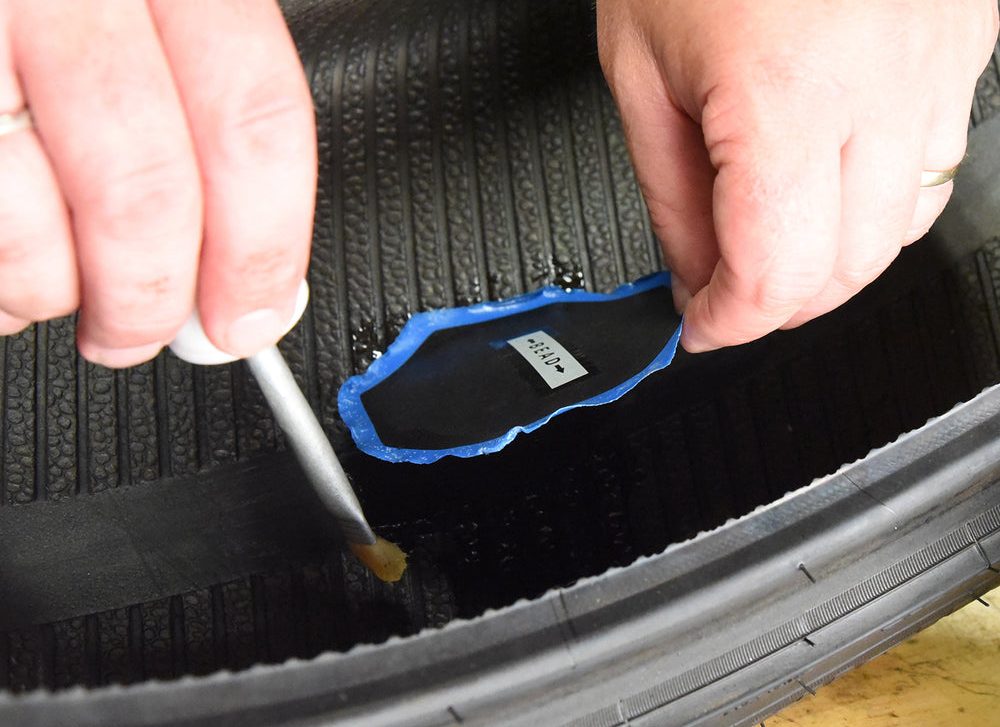 At the same time, such a repair patch must be very thin, flexible and not lose its properties when heated while driving. It is also important that it be light in weight so as not to cause an overall imbalance in a light radial tire.
At the same time, such a repair patch must be very thin, flexible and not lose its properties when heated while driving. It is also important that it be light in weight so as not to cause an overall imbalance in a light radial tire.
Repair patches as a base
Fungi, cords, pegs and sealing solutions can be used to repair minor damage. However, to repair more serious damage - breakdowns, a repair patch with a cord thread is needed. A puncture is considered to be a serious damage to the tire carcass if its diameter exceeds 6-8 mm and the carcass carrier cords are torn. In the course of repairing such damage, it is necessary to restore the integrity of the cord threads lost due to a break. To do this, a repair patch is applied to the breakdown site. It is very important that the damaged cord threads are completely covered with new patch threads. That is, the new cords of the patch should be tightly attached to the ends of the damaged threads, following their direction.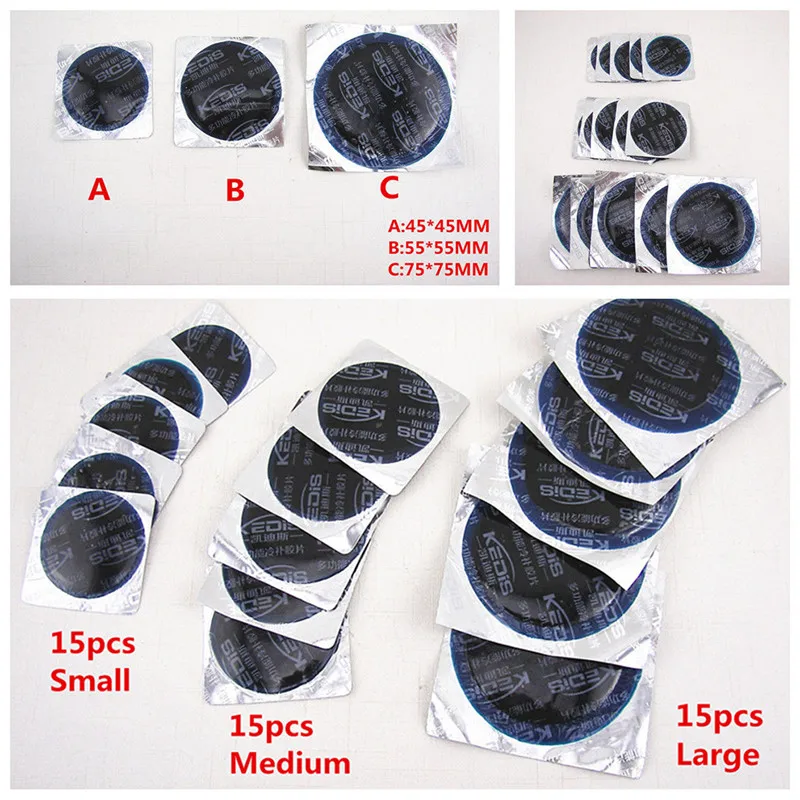
Bias Repair Patches
Bias Repair Patches are used to repair bias tire punctures. A feature of diagonal tires is that the cords are located crosswise, mainly at an angle of 90º. The cords of large tires for agricultural machinery are located at a large angle - 120º. In a similar way, the cord threads are located at the repair patches, which are superimposed on the damaged areas of the punctured tires. Patches for regular tires have 8 ply cords, for large tires - 16 plies.
Bias patches are used for repairs in the shoulder (fig. 1) or side (fig. 2) area of the tread. Bias constructions are currently used in the production of tires for agricultural machinery and trucks.
Radial Tire Repair Patches
Radial Tire Repair Patches are used to repair radial tire punctures. In a radial tire, the cord threads of the carcass have a radial arrangement. In the same way, load-bearing cords are made for repair patches for radial tires.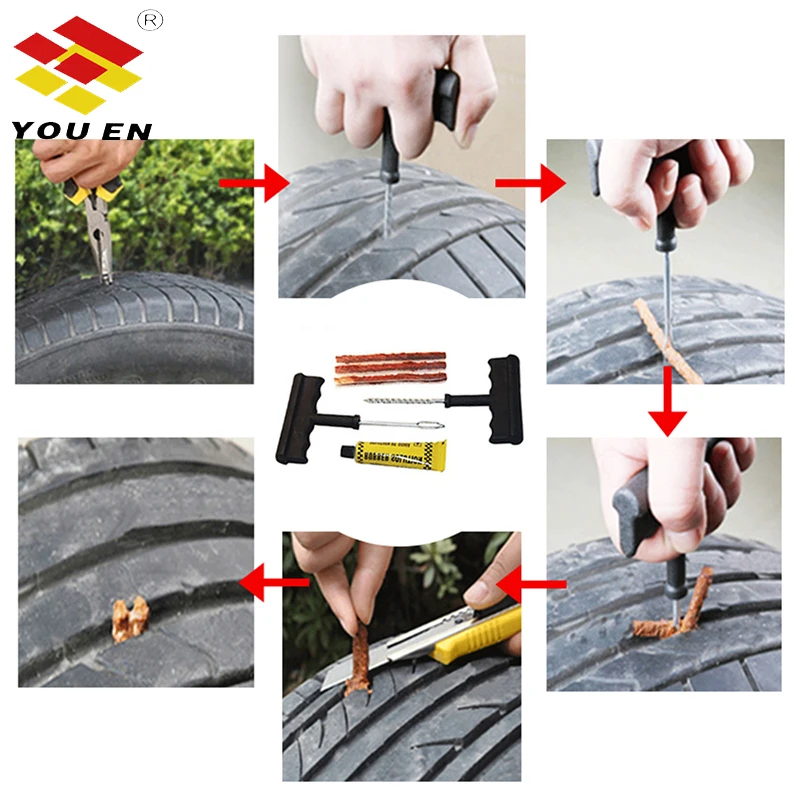 They are used to repair serious damage - breakdowns. In this case, a repair patch for the radial structure is placed in the tire, thus restoring the integrity of the damaged cords in the tire carcass. Since today all sizes of radial tires are repairable, there are several types of patches for radial tires:
They are used to repair serious damage - breakdowns. In this case, a repair patch for the radial structure is placed in the tire, thus restoring the integrity of the damaged cords in the tire carcass. Since today all sizes of radial tires are repairable, there are several types of patches for radial tires:
If a radial tire repair patch is used to repair a puncture, it is very important that deformation processes do not occur at the point of damage. First of all, it is necessary to avoid the occurrence of swelling. Although, to be honest, it will never be possible to completely avoid bloating. Firstly, this is impossible due to the fact that the tire material is always slightly stretched at the point of breakdown.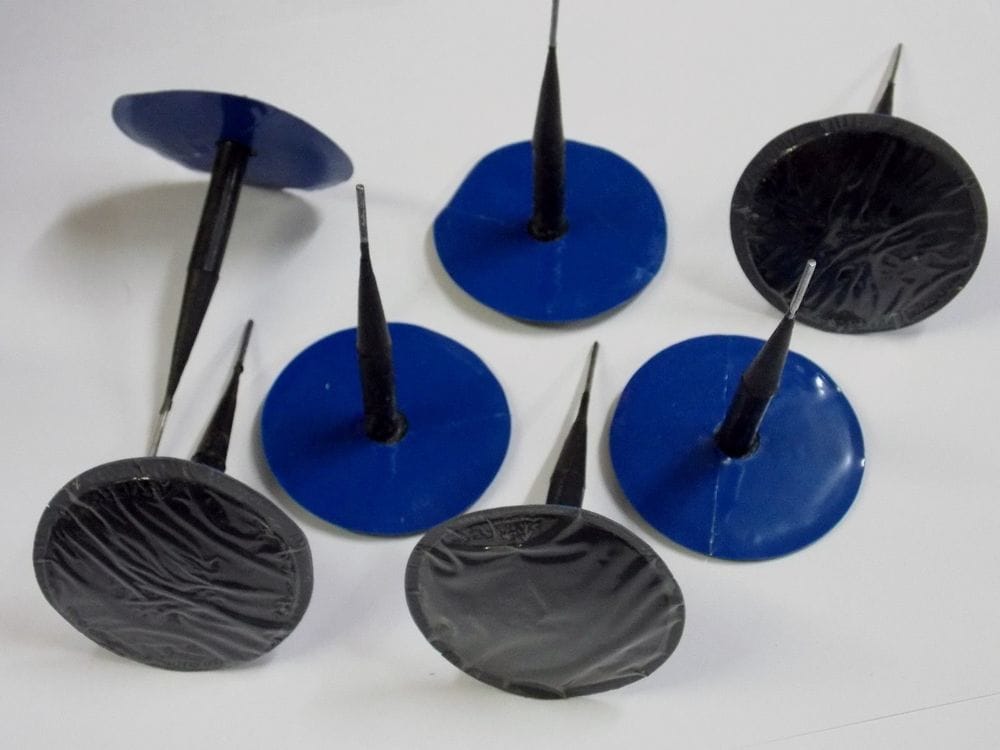 Moreover, after thermal exposure and subsequent vulcanization, it will stretch even more. Secondly, the slight bulge is due to the fact that the repair patch cords cannot be directly connected to the tire cords, and the flexible rubberized connecting layer between them provokes slippage and leads to a slight shear. However, when using patches with a carefully thought out design and the right material, bloating can be significantly reduced.
Moreover, after thermal exposure and subsequent vulcanization, it will stretch even more. Secondly, the slight bulge is due to the fact that the repair patch cords cannot be directly connected to the tire cords, and the flexible rubberized connecting layer between them provokes slippage and leads to a slight shear. However, when using patches with a carefully thought out design and the right material, bloating can be significantly reduced.
Standard patches for radial tires
Viscose or polyester cords are used to make standard patches. To increase the reliability of these patches, several layers of these threads are used during their manufacture. Regular patches have four layers, while larger patches have eight. These layers have a gradation according to the size and are interconnected by rubber. When the tire is loaded, the force from the tire carcass is gradually transferred by sliding stress to the individual layers of the patch, so there is practically no stress concentration at the ends of the patch and the load on the patch is distributed along its entire length. This is a significant advantage of standard radial tire patches, which is why they are constantly in high demand.
This is a significant advantage of standard radial tire patches, which is why they are constantly in high demand.
Among the disadvantages of such patches is greater elasticity, which is caused by the movement of forces between the individual layers and leads to more swelling on the side of the tire.
Steel Cord Radial Tire Patches
Steel cords are also used to make truck tire patches, which provide higher reliability and lower elasticity.
Their advantage is that they are more reliable and can only be in one or two layers. But there is also a reverse side of the coin, since at the junction of new and damaged cord threads there is a high concentration of stress on the ends of the patches. Therefore, quality patches with steel cords have an additional inner lining textile layer, which helps to more evenly distribute the impact of forces. Another advantage of these patches is the slight bulge when they are applied to the side of the tire.
But there is also a significant drawback - poor flexibility. Therefore, steel cord patches for radial tires are not suitable for repairing punctures in low profile tires.
Aramid patches for radial tires
Similar results as with steel cord patches for radial tires can be achieved by using patches with aramid cords. This material is as strong and reliable as steel, but much lighter. In addition, the individual fibers in aramid yarns are much thinner compared to steel wire. Therefore, patches with aramid cord have much more flexibility.
However, aramid cord patches have the same end stress concentration problem as steel cord patches. Therefore, it is necessary to place another layer in such patches, which will distribute the stress along the entire length. From this, of course, the thickness of the patch will increase and its initial advantage will be lost. But still, even in this version, aramid patches are quite flexible, so they are great for repairing the sides of low profile tires. The disadvantage of such patches is, of course, the high cost.
Crossbelt patches
These patches are the newest product on the market and are distinguished by the fact that they significantly reduce the occurrence of blisters during repairs on the side of the tire (fig. 6). The main material for the manufacture of patches with a transverse belt is high-quality polyester, distributed in several gradation layers, as in standard pads. Therefore, there is no need for a special layer for stress distribution.
The good resilience and effect of steel cord patches is achieved by using a narrow transverse belt. Due to the shape and material of the patches, which are concentrated exactly where it is needed, the cross-belt patches have increased flexibility and reliability. Therefore, they are excellent for more loaded low profile tires. And, undoubtedly, a significant advantage of patches with a transverse belt is their lower cost than patches with steel and aramid cords.
The development of breach repair
In the 60s and 70s of the last century, a great agreement was finally reached on how to repair breaches. At that time, the cold vulcanization method was significantly improved and repair patches began to be produced on an industrial basis by large enterprises. Large manufacturers were able to accurately determine the technological foundations of repair, after which they summarized them in basic rules and tables.
According to these principles, the repair of tire punctures is carried out in various ways today. Therefore, manufacturers can guarantee that if the master follows the established rules, he will be able to repair most damage. In this case, the repair will be quite successful.
In the past, when tires were expensive and manual work was cheap, there was an opinion that puncture repairs were always successful. Currently, it's the other way around. Before repair, it is already necessary to calculate the residual value of the damaged tire and the cost of the repair.
Owners of personal vehicles sometimes find it cheaper to buy new tires than to repair a major damage. Moreover, the requirements for driving comfort are increasing, which requires stability and increased tire balancing from the car. But since the tire loses its original qualities after repair, this method of repairing holes is less and less suitable for passenger car tires and is gradually moving into the category of truck, tractor, agricultural and special tires. This trend will become more pronounced in the future.
Nevertheless, today we can safely say that modern hole repair technologies are well developed and in most cases convenient. On the other hand, there are no other more convenient alternatives on the horizon. Therefore, in the future, only materials will be improved, especially repair patches, and the vulcanization system.
Repair does not end with patches alone
In this article, we have described in detail the types of patches for repairing breakdowns - cord patches, which restore the integrity of damaged cord threads in the tire carcass. But to be honest, the application of a repair patch is only one part of the technology for repairing breakdowns. Moreover, this is the least problematic way to repair damage.
Another, more complex method, involves welding the tire at the point of breakdown. Performing such repairs requires a higher level of professionalism, skills and decency from the master.
This work, often dirty, but responsible and creative, is still shrouded in mystery for many specialists even today. Therefore, we will talk about this repair method next time, so that for any master it turns from a mystery into a logically consistent and easily understandable process.
Pavel Ferdus
This helpful tire repair guide describes the basic ways to repair a punctured tyre, tires that cannot be repaired, and issues that can lead to a puncture. There are several repair options available when you hit a nail or other debris that punctures your tire.
A specialist workshop must have everything for tire repair in its arsenal. The quality of the tire repair performed will depend on the quality of the consumables available. For high-quality tire repair, you will need high-quality REMA TIP TOP materials. Everything for repairing REMA TIP TOP tires can be bought on the website https://fenix-market.com/ru/ of the Phoenix-Market company. Over the years of successful activity, Phoenix-Market has established itself in the car service market as a reliable supplier of equipment for service stations and tire fitting, as well as tire repair materials.
Thermopress Electric Vulcanizer at fenix-market.comrepair, and problems that can lead to a tire puncture.
Tire Repair Options
There are several tire repair options when you hit a nail or other debris that punctures your tire. While all of these repairs cover a puncture, they are not equal in quality, safety, or durability.
Tire Sealants are for emergency use only and should never be considered a permanent repair. After sealing the tire, immediately go to a repair shop to have the tire inspected and properly repaired or replaced.
When you get to the tire shop, be sure to tell the technician that there is sealant in the tire. Without this warning, the technician could end up with a huge amount of sealant on the floor.
As soon as you drive the car, the heat vulcanizes the rubber and seals the hole. A busbar has several advantages. Firstly, this is a quick repair that does not require dismantling the tires from the wheels. It's also generally cheaper and you can do it yourself in a pinch.
However, a tire plug is not a permanent repair. Plugs are for temporary use only because they tend to leak and can slowly come out of the hole at high speeds. Also, plugs can allow water to seep in and cause rust on the wheels and steel bands that hold the tire in place.
A tire patch is better than a plug because there is no risk of it flying out at high speed. In addition, it creates a more secure seal as it closes the hole and its surroundings. However, patches tend to be more expensive because they take more time and require the technician to balance the tire. The standard patch also does not fill the puncture, which can lead to leakage in the future.
Not every tire puncture can be repaired - patches and plugs have their own design limitations. Here are a few cases where a tire is simply beyond repair.
Large punctures
Regardless of which type of tire fitting you choose - plug or patch - the maximum diameter of a puncture that you can safely repair is 6 mm. Anything larger can cause a leak, which could lead to bigger problems down the road.
Shoulder punctures
All tires have two main tread sections. The tire contact patch is the most central part of the tread between the outer tread channels - circumferential grooves in the tires. The shoulder of a tire is the area between the outermost channels and each sidewall.
The shoulders of the bar not only support a large load, but also have a slight bend, which makes them unsuitable for patches or plugs. If you have a puncture in your shoulder, the tire is beyond repair, so a new tire is your only option.
Sidewall punctures
The sidewall of a tire—the vertical surface on each side of the tire—is not rigid enough to support a plug or patch.